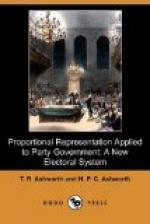Is it too much to say that, if the Hobart experiment be persevered with, the ultimate tendency will be the return of six members, each acceptable to one-sixth of the electors, and obnoxious to the other five-sixths? It is quite obvious already that the usual party lines are entirely disregarded.
+Professor Commons.+—The best book on the subject yet published is the “Proportional Representation” of John E. Commons, Professor of Sociology in Syracuse University, U.S. Its great merit is that the political and social bearings of the reform are fully treated. Professor Commons rejects the Hare system in favour of the Free List system. He writes:—“The Hare system is advocated by those who, in a too doctrinaire fashion, wish to abolish political parties. They apparently do not realize the impossibility of acting in politics without large groupings of individuals.” He makes a great step in advance of the disciples of Mr. Hare in recognizing that the proportional principle should be applied to parties, and not to individuals, and he even defines parties correctly as being based “not altogether on sectional divisions, but on social and economic problems of national scope;” but, unfortunately, he fails to see that there can be only two parties, and that the representation of small parties would not reform the main parties, but break them up altogether. At the same time he is no mere theorist, for he declares:—“If a practicable and effective method of proportional representation cannot be discovered, the theoretical principle is a mere dream.” Moreover, he prudently recognizes that his arguments as regards Federal and State Legislatures in America are in advance of what the public is ready to accept, and adds:—“We, as a people are not yet ready to abandon the notion that party responsibility in Federal affairs is essential to safety.” His immediate object is, therefore, the reform of city councils, which in America are controlled by the national parties, and are exploited by the notorious “machine” organizations. We may sympathize with this object, for parties in an administrative body are a serious evil, but with legislatures the case is quite different. Professor Commons admits that third and fourth parties, if given their proportionate weight in legislation, would hold the balance of power, but he declares that “the




